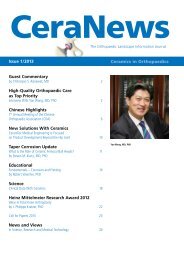BIOLOX - Nanocomposite for Arthoplasty
The Fourth Generation of Ceramics
The Fourth Generation of Ceramics
You also want an ePaper? Increase the reach of your titles
YUMPU automatically turns print PDFs into web optimized ePapers that Google loves.
Hardness and Toughness Combined<br />
An Optimal Composite<br />
The extremely stable ceramic bond virtually<br />
rules out any possibility of plastic de<strong>for</strong>mation.<br />
While this permits the desired degree<br />
of extreme hardness, it also leads to a<br />
relatively high degree of brittleness. However,<br />
given the right material design, one<br />
can achieve both extreme hardness and<br />
strength. Such composite models exist in<br />
nature and in modern technology.<br />
Proven Models<br />
Sea snails protect themselves with shells<br />
made of a finely tuned mixture of hard and<br />
brittle aragonite and thin and very elastic<br />
intermediate layers of proteins and chitin.<br />
More than 2000 years ago, blacksmiths<br />
discovered how to combine very hard<br />
high-carbon and ductile low-carbon alloys<br />
to <strong>for</strong>m a superior composite, the legendary<br />
Damascene steel.<br />
7<br />
Damascene steel combines<br />
hard and ductile alloys<br />
to <strong>for</strong>m a highly firm and<br />
resistant material.<br />
Source: stienenDamast, Mönchengladbach, Germany<br />
The protective pearl shell<br />
combines hardness and<br />
strength. It consists of hardbrittle<br />
aragonite and very<br />
elastic layers of protein and<br />
chitin.<br />
Source: J.D. Verhoeven, A.H. Pendray, W.E. Dauksch, Journal of Metals,<br />
vol. 50, No. 9, p. 60 (1998)












